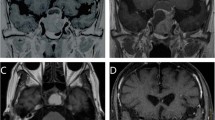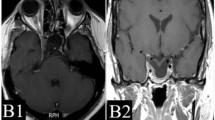Abstract
Gamma Knife radiosurgery is often used in pituitary adenomas. Aim of our study is to describe the characteristics and long-term outcome of patients with adenoma recurrence after Gamma Knife radiosurgery. We conducted a retrospective analysis of patients with pituitary adenoma treated by Gamma Knife radiosurgery between 1994 and 2014. Tumor recurrence was labeled as “in field” when the tumor growth occurred adjacent or within the prescribed isodose, whereas it was classified as “out of field” when the tumor growth occurred outside the prescribed isodose. Five hundred forty-three patients were included, 272 (50.1 %) had a nonfunctioning pituitary adenoma (NFPA) and 271 (49.9 %) patients had a hormone secreting-pituitary adenoma. The median follow-up after GKRS was 78 months (IQR, 36-125 months). Thirty-nine patients (7.2 %) had recurrence of disease and it was more frequent in patients with NFPA than in patients with hormone secreting adenomas (9.6 % vs. 4.8 %). The 10-yr progression-free survival in patients with NFPA was 78.7 % (95 % CI 69.5 – 87.9 %), as compared with 93.3 % (95 % CI 89.3 – 97.3 %; p < 0.01) in hormone secreting adenomas. Tumor recurrence was “in field” in 17 cases (43.6 %) and “out of field” in 22 cases (56.4 %). Seven of the 39 patients with recurrence died despite further treatments. Six of these patients had an “in field” recurrence. Recurrence of a pituitary adenoma after GKRS may occur several years after initial treatment. Distinction between “in field” and “out of field” tumor recurrence probably reflects two different pathophysiological mechanisms and may have prognostic importance.



Similar content being viewed by others
References
J.P. Sheehan, A. Niranjan, J.M. Sheehan, J.A. Jane Jr, E.R. Laws, D. Kondziolka et al., Stereotactic radiosurgery for pituitary adenomas: an intermediate review of its safety, efficacy, and role in the neurosurgical treatment armamentarium. J. Neurosurg. 102(4), 678–691 (2005)
G. Minniti, D.C. Gilbert, M. Brada, Modern techniques for pituitary radiotherapy. Rev. Endocr. Metab. Disord. 10(2), 135–144 (2009). doi:10.1007/s11154-008-9106-0
M. Losa, M. Valle, P. Mortini, A. Franzin, C. Ferrari da Passano, M. Cenzato et al., Gamma knife surgery for treatment of residual nonfunctioning pituitary adenomas after surgical debulking. J. Neurosurg. 100(3), 438–444 (2004)
V. Mingione, C.P. Yen, M.L. Vance, M. Steiner, J. Sheehan, E.R. Laws et al., Gamma surgery in the treatment of nonsecretory pituitary macroadenoma. J. Neurosurg. 104(6), 876–883 (2006)
J.P. Sheehan, R.M. Starke, D. Mathieu, B. Young, P.K. Sneed, V.L. Chiang et al., Gamma Knife radiosurgery for the management of nonfunctioning pituitay adenomas: a multicenter study. J. Neurosurg. 119(2), 446–456 (2013). doi:10.3171/2013.3.JNS12766
M. Losa, L. Gioia, P. Picozzi, A. Franzin, M. Valle, M. Giovanelli et al., The role of stereotactic radiotherapy in patients with growth hormone-secreting pituitary adenoma. J. Clin. Endocrinol. Metab. 93(7), 2546–2552 (2008). doi:10.1210/jc.2008-0135
B.E. Pollock, P.D. Brown, T.B. Nippoldt, W.F. Young Jr, Pituitary tumor type affects the chance of biochemical remission after radiosurgery of hormone-secreting pituitary adenomas. Neurosurgery 62(6), 1271–1276 (2008). doi:10.1227/01.neu.0000333298.49436.0e discussion 1276-1278
F. Castinetti, M. Nagai, I. Morange, H. Dufour, P. Caron, P. Chanson et al., Long-term results of stereotactic radiosurgery in secretory pituitary adenomas. J. Clin. Endocrinol. Metab. 94(9), 3400–3407 (2009). doi:10.1210/jc.2008-2772
C.C. Lee, M.L. Vance, Z. Xu, C.P. Yen, D. Schlesinger, B. Dodson et al., Stereotactic radiosurgery for acromegaly. J. Clin. Endocrinol. Metab. 99(4), 1273–1281 (2014). doi:10.1210/jc.2013-3743
M. Losa, P. Mortini, R. Barzaghi, P. Ribotto, M.R. Terreni, S. Bianchi Marzoli et al., Early results of surgery in patients with nonfunctioning pituitary adenoma and analysis of the risk of tumor recurrence. J. Neurosurg. 108(3), 525–532 (2008). doi:10.3171/JNS/2008/108/3/0525
I.J. Pomeraniec, R.F. Dallapiazza, Z. Xu, J.A. Jane Jr, J.P. Sheehan, Early versus late Gamma Knife radiosurgery following transsphenoidal resection for nonfunctioning pituitary adenomas: a matched cohort study. J. Neurosurg. Published online October 30, 2015; doi: 10.3171/2015.5.JNS15581
B. Wowra, W. Stummer, Efficacy of gamma knife radiosurgery for nonfunctioning pituitary adenomas: a quantitative follow up with magnetic resonance imaging-based volumetric analysis. J. Neurosurg. 97(5 Suppl), 429–432 (2002)
Z. Petrovich, C. Yu, S.L. Giannotta, C.S. Zee, M.L. Apuzzo, Gamma knife radiosurgery for pituitary adenoma: early results. Neurosurgery 53(1), 51–59 (2003). discussion 59–61
T. Kobayashi, Long-term results of stereotactic gamma knife radiosurgery for pituitary adenomas. Specific strategies for different types of adenoma. Prog. Neurol. Surg. 22, 77–95 (2009). doi:10.1159/000163384
R. Liscak, V. Vladyka, J. Marek, G. Simonova, J. Vymazal, Gamma knife radiosurgery for endocrine-inactive pituitary adenomas. Acta Neurochir. (Wien) 149(10), 999–1006 (2007). discussion 1006
B.E. Pollock, J. Cochran, N. Natt, P.D. Brown, D. Erickson, M.J. Link et al., Gamma knife radiosurgeryfor patients with nonfunctioning pituitary adenomas: results from a 15-year experience. Int. J. Radiat. Oncol. Biol. Phys. 70(5), 1325–1329 (2008)
C. Hoybye, T. Rahn, Adjuvant Gamma Knife radiosurgery in non-functioning pituitary adenomas; low risk of long-term complications in selected patients. Pituitary 12(3), 211–216 (2009). doi:10.1007/s11102-008-0163-x
K.A. Øystese, J.A. Evang, J. Bollerslev, Non-functioning pituitary adenoma: growth and aggressiveness. Endocrine 53(1), 28–34 (2016). doi:10.1007/s12020-016-0940-7
F. Castinetti, M. Nagai, H. Dufour, J.M. Kuhn, I. Morange, P. Jacquet et al., Gamma knife radiosurgery is a successful adjunctive treatment in Cushing’s disease. Eur. J. Endocrinol. 156(1), 91–98 (2007)
H. Wan, O. Chihiro, S. Yuan, MASEP gamma knife radiosurgery for secretory pituitary adenomas: experience in 347 consecutive cases. J. Exp. Clin. Cancer Res. 28, 36 (2009). doi:10.1186/1756-9966-28-36
X. Liu, H. Kano, D. Kondziolka, K.J. Park, A. Iyer, S. Shin et al., Gamma knife stereotactic radiosurgery for drug resistant or intolerant invasive prolactinomas. Pituitary 16(1), 68–75 (2013)
J.P. Sheehan, Z. Xu, D.J. Salvetti, P.J. Schmitt, M.L. Vance, Results of gamma knife surgery for Cushing’s disease. J. Neurosurg. 119(6), 1486–1492 (2013). doi:10.3171/2013.7.JNS13217
M. Losa, F. Bogazzi, S. Cannavo, F. Ceccato, L. Curtò, L. De Marinis et al., Temozolomide therapy in patients with aggressive pituitary adenomas or carcinomas. J. Neurooncol. 126(3), 519–525 (2016). doi:10.1007/s11060-015-1991-y
Author information
Authors and Affiliations
Corresponding author
Ethics declarations
Conflict of interest
The authors declare that they have no conflict of interest.
Rights and permissions
About this article
Cite this article
Losa, M., Spatola, G., Albano, L. et al. Frequency, pattern, and outcome of recurrences after gamma knife radiosurgery for pituitary adenomas. Endocrine 56, 595–602 (2017). https://doi.org/10.1007/s12020-016-1081-8
Received:
Accepted:
Published:
Issue Date:
DOI: https://doi.org/10.1007/s12020-016-1081-8




